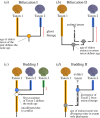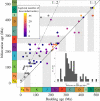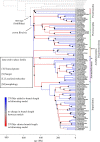Calibrating phylogenies assuming bifurcation or budding alters inferred macroevolutionary dynamics in a densely sampled phylogeny of bivalve families
- PMID: 34847770
- PMCID: PMC8634622
- DOI: 10.1098/rspb.2021.2178
Calibrating phylogenies assuming bifurcation or budding alters inferred macroevolutionary dynamics in a densely sampled phylogeny of bivalve families
Abstract
Analyses of evolutionary dynamics depend on how phylogenetic data are time-scaled. Most analyses of extant taxa assume a purely bifurcating model, where nodes are calibrated using the daughter lineage with the older first occurrence in the fossil record. This contrasts with budding, where nodes are calibrated using the younger first occurrence. Here, we use the extensive fossil record of bivalve molluscs for a large-scale evaluation of how branching models affect macroevolutionary analyses. We time-calibrated 91% of nodes, ranging in age from 2.59 to 485 Ma, in a phylogeny of 97 extant bivalve families. Allowing budding-based calibrations minimizes conflict between the tree and observed fossil record, and reduces the summed duration of inferred 'ghost lineages' from 6.76 billion years (Gyr; bifurcating model) to 1.00 Gyr (budding). Adding 31 extinct paraphyletic families raises ghost lineage totals to 7.86 Gyr (bifurcating) and 1.92 Gyr (budding), but incorporates more information to date divergences between lineages. Macroevolutionary analyses under a bifurcating model conflict with other palaeontological evidence on the magnitude of the end-Palaeozoic extinction, and strongly reduce Cenozoic diversification. Consideration of different branching models is essential when node-calibrating phylogenies, and for a major clade with a robust fossil record, a budding model appears more appropriate.
Keywords: Mollusca; ghost lineage; lineage-through-time; mass extinction; time calibration.
Figures





Similar articles
-
An evaluation of fossil tip-dating versus node-age calibrations in tetraodontiform fishes (Teleostei: Percomorphaceae).Mol Phylogenet Evol. 2015 Jan;82 Pt A:131-45. doi: 10.1016/j.ympev.2014.10.011. Epub 2014 Oct 24. Mol Phylogenet Evol. 2015. PMID: 25462998
-
A phylogeny of Cenozoic macroperforate planktonic foraminifera from fossil data.Biol Rev Camb Philos Soc. 2011 Nov;86(4):900-27. doi: 10.1111/j.1469-185X.2011.00178.x. Epub 2011 Apr 15. Biol Rev Camb Philos Soc. 2011. PMID: 21492379
-
The fossil record of spiders revisited: implications for calibrating trees and evidence for a major faunal turnover since the Mesozoic.Biol Rev Camb Philos Soc. 2020 Feb;95(1):184-217. doi: 10.1111/brv.12559. Epub 2019 Nov 12. Biol Rev Camb Philos Soc. 2020. PMID: 31713947
-
Vicariance and dispersal in southern hemisphere freshwater fish clades: a palaeontological perspective.Biol Rev Camb Philos Soc. 2019 Apr;94(2):662-699. doi: 10.1111/brv.12473. Epub 2018 Oct 19. Biol Rev Camb Philos Soc. 2019. PMID: 30338909 Review.
-
'Fish' (Actinopterygii and Elasmobranchii) diversification patterns through deep time.Biol Rev Camb Philos Soc. 2016 Nov;91(4):950-981. doi: 10.1111/brv.12203. Epub 2015 Jun 23. Biol Rev Camb Philos Soc. 2016. PMID: 26105527 Review.
Cited by
-
Ocean Species Discoveries 1-12 - A primer for accelerating marine invertebrate taxonomy.Biodivers Data J. 2024 Aug 6;12:e128431. doi: 10.3897/BDJ.12.e128431. eCollection 2024. Biodivers Data J. 2024. PMID: 39171079 Free PMC article.
-
Diversity, distribution and intrinsic extinction vulnerability of exploited marine bivalves.Nat Commun. 2023 Aug 15;14(1):4639. doi: 10.1038/s41467-023-40053-y. Nat Commun. 2023. PMID: 37582749 Free PMC article.
-
Mitonuclear compatibility is maintained despite relaxed selection on male mitochondrial DNA in bivalves with doubly uniparental inheritance.Evolution. 2024 Oct 28;78(11):1790-1803. doi: 10.1093/evolut/qpae108. Evolution. 2024. PMID: 38995057 Free PMC article.
-
Key Adaptive Trait Promotes Contrasting Modes of Diversification in a Bivalve Clade.Evol Biol. 2025;52(1):26-39. doi: 10.1007/s11692-024-09643-6. Epub 2024 Nov 28. Evol Biol. 2025. PMID: 39968058 Free PMC article.
-
The end-Cretaceous mass extinction restructured functional diversity but failed to configure the modern marine biota.Sci Adv. 2025 May 23;11(21):eadv1171. doi: 10.1126/sciadv.adv1171. Epub 2025 May 21. Sci Adv. 2025. PMID: 40397748 Free PMC article.
References
-
- Wagner PJ. 2019. On the probabilities of branch durations and stratigraphic gaps in phylogenies of fossil taxa when rates of diversification and sampling vary over time. Paleobiology 45, 30-55. (10.1017/pab.2018.35) - DOI
-
- Foote M. 1996. On the probability of ancestors in the fossil record. Paleobiology 22, 141-151. (10.1017/S0094837300016146) - DOI
Publication types
MeSH terms
Associated data
LinkOut - more resources
Full Text Sources

